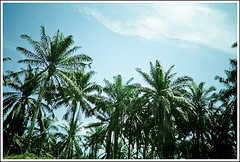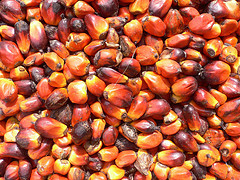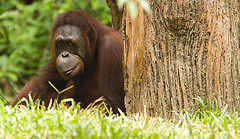Factsheet
Palm Oil
Have you heard of palm oil? How about vegetable oil or olive oil? Oils from plants, vegetables, seeds and nuts have been used for centuries all over the world for many different foods and products, so what makes palm oil such a controversial product?
Where Does Palm oil Come From?

Palm oil is an edible vegetable oil that is made from the fruits of the African (and sometime the American) oil palm tree. These trees grow hundreds of little orangey red fruits that are squashed, squeezed and pulped to produce palm oil. At the centre of the oil palm fruits, much like a nectarine, there is a stone, or ‘kernel’ and this is chopped and mashed up to produce the high protein ingredients palm kernel meal and palm kernel oil.
Oil palms are native to Africa, where palm oil has been used in cooking for thousands of years. The trees grow naturally in tropical rainforests but are now also being planted on farms so that people can produce more oil. First brought to Asia as ornamental trees, oil palms have now become a staple crop, with Indonesia and Malaysia supplying over 85% of the world’s palm oil annually. Indonesia is the world’s largest producer of palm oil, producing a huge 51.8 million tonnes of it in 2019. Until 1934, Nigeria had been the world's largest producer and, in 2018, the country was still the third largest palm oil producer in the world. Thailand also produces huge quantities of unrefined crude palm oil, most of which is used locally rather than being imported.
Palm oil is also grown in other African countries, though plantations have so far been kept relatively small for fear of damaging biodiversity and due to concerns about fuel crops taking over space that is needed to grow food.
What is Palm oil Used for?
Palm oil is a common cooking ingredient in the tropical belt of Africa, Southeast Asia and parts of Brazil, where it is used in the same way that other vegetable oils are commonly used in the West. As it is solid at room temperature in cooler climates, palm oil makes a cheap, vegetarian substitute for butter or other solid fats used in baking. It is used extensively in the production of a range of processed foods. In fact, in the UK, it is estimated that 33% of all the products in a local supermarket contain palm oil - that’s a lot of products! It is used in bread, cereals, chocolates, pizzas, cleaning products, chewing gum and even shampoo.
Palm oil’s high saturate content makes it ideal for creating a crispy coating on fried products, but also make it a useful addition to lipsticks, where it adds a glossy look, or to cleaning products, where it creates foam. The famous soap brand ‘Palmolive’ was named after the palm and olive oils that gave it a smooth texture.
As well as being used in products for human consumption, palm oil is widely used in animal feed. The UK uses a considerable 10% of the global supply in palm kernel meal, and 80% of this is used to feed pets and livestock. Palm oil has also been used to make milk substitutes to feed to calves in dairies!
 Palm oil isn’t only used for food and beauty products, it can also be used as a fuel, known as a ‘biodiesel’ (a non fossil fuel, created from living materials, such as plants). More than 50% of the palm oil imported into Europe in 2018 was used for vehicle fuel. The shells of the palm that have had their pulp extracted to make oil, can be used to make biofuels themselves. Palm oil can also be reused. After it has been used to fry foods, used cooking oil can be chemically treated to create a biodiesel for use in vehicles or for heating. Ironically, palm oil was first sought out as a biofuel, in an attempt to find a more environmentally friendly alternative to existing fossil fuels. However, studies suggest that palm oil biodiesel produces three times as much carbon a a fossil fuel equivalent.
Palm oil isn’t only used for food and beauty products, it can also be used as a fuel, known as a ‘biodiesel’ (a non fossil fuel, created from living materials, such as plants). More than 50% of the palm oil imported into Europe in 2018 was used for vehicle fuel. The shells of the palm that have had their pulp extracted to make oil, can be used to make biofuels themselves. Palm oil can also be reused. After it has been used to fry foods, used cooking oil can be chemically treated to create a biodiesel for use in vehicles or for heating. Ironically, palm oil was first sought out as a biofuel, in an attempt to find a more environmentally friendly alternative to existing fossil fuels. However, studies suggest that palm oil biodiesel produces three times as much carbon a a fossil fuel equivalent.
Why is Palm Oil a Problem?

The environmental issues with palm oil are largely due to the places where the palm trees are planted. Palm oil is a valuable crop and growing it can make farmers a lot of money. In fact, the governments of countries such as Indonesia have provided grants to farmers who choose to grow palm oil in an attempt to lift areas of the country out of poverty.
Unfortunately, the desire for more and more land on which to grow palm oil, has caused farmers to cut down and/ or burn areas of rainforest in order to make room. This habitat destruction has had devastating effects on the biodiversity of huge swathes of land as well as driving endangered animals such as orangutans, tigers and rhinos to the brink of extinction. Habitat loss caused by palm oil farming is believed to be the biggest threat to the survival of both the critically endangered Sumatran orangutan and the endangered Bornean orangutan. Indigenous peoples have also found themselves displaced by plantations encroaching onto their lands, forcing them to seek refuge.
Indonesia and Malaysia produce 86% of the world's palm oil. Palm oil production is such a huge business in Indonesia that the country has gained the title of “World’s Fastest Rainforest Destroyer” in the Guinness Book of World Records.
As well as causing habitat and biodiversity loss, palm oil plantations are responsible for enormous carbon emissions. Valuable trees are harvested and the rest are burnt to clear the land for the farming of palm oil. Burning the trees and the peatlands beneath them is highly polluting, although the ash improves the soil’s fertility before planting. In burning the rainforests Indonesia is also burning the peatlands below which store masses of carbon. Indonesia’s peatlands cover just 0.1% of the Earth’s land, yet contribute to 4% of the world’s greenhouse gases. This makes Indonesia the country with the 3rd largest carbon footprint in the world, when deforestation is taken into account!
In some countries, land that could be being used to grow food crops for local populations, is being used to grow palm oil for sale abroad. This has led to concerns that the need for fuel is being placed ahead of the need for food, leading to malnutrition in developing nations.
There are also reports of terrible human rights violations occurring in the palm oil production process with young children being used as cheap labour and many people being subjected to cruel and abusive behaviour.
Credits
Image: Palm Oil by oneVillage Initiative
Information sourced from:
Greenpalm.org, What Is Palm Oil Used For? (Online), Available From: https://greenpalm.org/about-palm-oil/what-is-palm-oil/what-is-palm-oil-used-for [Accessed on 11/1/21]
BBC Newsround, 2018, What is palm oil and why is it thought to be bad? (Online), Available from: https://www.bbc.co.uk/newsround/39492207 [Accessed on 11/1/21]
Ensia, 2014, How Did Palm Oil Become Such A Problem and What Can We Do About It? by Michael Kodas, (Online), Available from: https://ensia.com/features/how-did-palm-oil-become-such-a-problem-and-what-can-we-do-about-it/ [Accessed on 11/1/21]
The Guardian, February 2019, How The World Got Hooked on Palm Oil, by Paul Tullis, (Online), Available from: https://www.theguardian.com/news/2019/feb/19/palm-oil-ingredient-biscuits-shampoo-environmental [Accessed on 11/1/21]
Ecosia, April 2019, Why is Palm Oil Bad For The Environment? (Online), Available from: https://blog.ecosia.org/why-palm-oil-bad-environment-indonesia-sumatra-orangutan-habitats-ecosia/ [Accessed on 11/1/21]
Smithsonian Magazine, March 2016, Giving Up Palm Oil Might Actually Be Bad For The Environment, by Joe Fassler, (Online), Available from: https://www.smithsonianmag.com/science-nature/giving-up-palm-oil-might-actually-be-bad-environment-180958092/ [Accessed on 11/1/21]
A palm by any other name
In 2014, the EU changed the law to say that any product containing palm oil must say so in the ingredients list. However, palm oil products have many other names! In non EU products, palm oil is often listed simply as “Vegetable Oil” or “Vegetable Fat”. Furthermore, every single one of the ingredients listed below actually comes from the palm oil tree. Have a look at some of the products you have at home and see how many contain at least one of these!
Palm Kernel, Palm Kernel Oil, Palm Fruit Oil, Palmate, Palmitate, Palm olein, Glyceryl, Stearate, Stearic Acid, Elaeis Guineensis, Palmitic Acid, Palm Stearine, Palmitoyl Oxostearamide, Palmitoyl Tetrapeptide-3, Sodium Laureth Sulfate, Sodium Lauryl Sulfate, Sodium Kernelate, Sodium Palm Kernelate, Sodium Lauryl Lactylate/Sulphate, Hydrated Palm Glycerides, Etyl Palmitate, Octyl Palmitate, Palmityl Alcohol, Laureth-7, Steareth-2, Cocamide MEA (fatty acid-derived) Cocamiede DEA (fatty acid derived), Stearamidopropyldimethylamine, Cetyltrimethylammonium chloride, Isopropylmyristate, Caprylic/capric Trigylceride, Fatty Isethionates (SCI), Alkylpolyglycoside (APG), Laurylamine oxide.
Should we Stop Using Palm Oil?
With all these negative impacts on the environment, should people stop using palm oil altogether? It’s not actually as simple as that.
Palm oil provides an income for millions of people and allows them to afford food, medical care and education for their children. Palm oil makes up about 10% of all Indonesian exports and 5% of Malaysia’s, making it their most important agricultural export. Millions of people’s livelihoods are dependent on this business.
Palm oil is also a very efficient crop, because both the fruit and the stone of the tree can be used to make oil. The trees also grow well in many types of soil and they are evergreen, producing fruits all year round. As a result, an oil palm plantation is up to ten times more productive than the same amount of space would be if producing a different vegetable oil such as rapeseed, or soy. While only 5% of the world's vegetable oil farmland is used for palm plantations, palm cultivation produces 38% of the world's total vegetable oil supply.
This means that, if people were to stop using palm oil, they would soon move on to using a less efficient oil, which would take even more farmland to grow in big enough quantities!
What can be Done to Improve the Situation?
Instead of boycotting palm oil altogether, businesses are being encouraged to buy their palm oil from more sustainable sources.
The RSPO (Roundtable on Sustainable Palm Oil) was set up in 2001, with representatives from 40% of the palm oil industry, to provide a set of ethical and ecological standards for the production of palm oil. Farmers had to commit to practices that avoided habitat destruction and instead, try to find ways to increase the yield from the trees they already had.
Attempts are being made to breed from the most productive trees, genetically modifying plantations to be more productive over time. There are also big increases in yield to be had from changing the time that fertiliser is used. “Right now the average yield in Malaysia and Indonesia is 18 ½ tons of fresh fruit bunches per hectare. In places with the best management practices, they’re already getting 30 tons per hectare,” says Philip Taylor from the University of Colorado.
Sustainable palm oil farms are also being developed on non forest land in places such as Columbia, where people are being encouraged to grow palm oil instead of other illegal crops.
In 2012 the UK Government set a commitment for 100% of the palm oil used in the UK to be from sustainable sources that don’t harm nature or people. In 2016 75% of the total palm oil imports to the UK were sustainable. However, even when a palm oil mill labels its products as ‘sustainable’ it can be very difficult to prove whether this is true. It’s possible for an oil to be labelled in this way when only a tiny percentage of the palm fruits have come from a sustainable source.
Combine this with the fact that certified palm oil is more expensive than non sustainable versions and clearly there its still a long way to go to improve things. Outside the EU, there is little interest in buying sustainable palm oil over cheaper versions and while this is the case, there will always be a limit to how effective the RSPO can be.


 Palm oil isn’t only used for food and beauty products, it can also be used as a fuel, known as a ‘biodiesel’ (a non fossil fuel, created from living materials, such as plants). More than 50% of the palm oil imported into Europe in 2018 was used for vehicle fuel. The shells of the palm that have had their pulp extracted to make oil, can be used to make biofuels themselves. Palm oil can also be reused. After it has been used to fry foods, used cooking oil can be chemically treated to create a biodiesel for use in vehicles or for heating. Ironically, palm oil was first sought out as a biofuel, in an attempt to find a more environmentally friendly alternative to existing fossil fuels. However, studies suggest that palm oil biodiesel produces three times as much carbon a a fossil fuel equivalent.
Palm oil isn’t only used for food and beauty products, it can also be used as a fuel, known as a ‘biodiesel’ (a non fossil fuel, created from living materials, such as plants). More than 50% of the palm oil imported into Europe in 2018 was used for vehicle fuel. The shells of the palm that have had their pulp extracted to make oil, can be used to make biofuels themselves. Palm oil can also be reused. After it has been used to fry foods, used cooking oil can be chemically treated to create a biodiesel for use in vehicles or for heating. Ironically, palm oil was first sought out as a biofuel, in an attempt to find a more environmentally friendly alternative to existing fossil fuels. However, studies suggest that palm oil biodiesel produces three times as much carbon a a fossil fuel equivalent.
